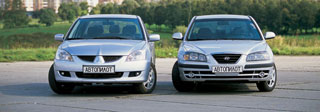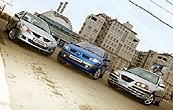Test drive Mitsubishi Lancer Evolution VII 2000 - 2003 sedan
Product "Nexus 7"
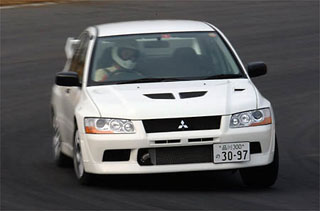 On January 26, 2001, the Mitsubishi Lancer Evolution VII car went on sale. It should be noted that this is the first machine of the Lancer Evolution family, which is made on the basis of the Lancer Sedia model. The car is equipped with a new ACD system, which is borrowed from the arsenal of racing cars. The Japanese car journalist Mori Kate decided to run into him, and not somewhere, but on the famous ring track of Tsukuba.
On January 26, 2001, the Mitsubishi Lancer Evolution VII car went on sale. It should be noted that this is the first machine of the Lancer Evolution family, which is made on the basis of the Lancer Sedia model. The car is equipped with a new ACD system, which is borrowed from the arsenal of racing cars. The Japanese car journalist Mori Kate decided to run into him, and not somewhere, but on the famous ring track of Tsukuba. Chasing in a circle - business entertaining
I hate to move around the vicious circle. I am scared by flying at high speed of the car. But, having been driving Lancer Evolution VII, I began to suspect that it was probably too early to put a cross in this regard.
In fact, Lancer Evolution under my beginning behaved in strict accordance with my plans, or, better to say, satisfied all my desires. But what about my inflated fears - not to fit into a turn, for example? None of this happened. Having at its disposal a 2-liter engine, complemented by turbocharged, with a capacity of 280 horses, you can get real pleasure from driving. What I actually did!
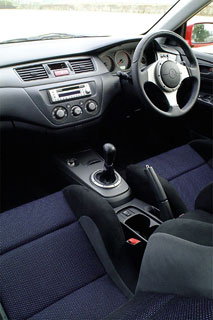 And if before that I believed that the race is when the driver is trying to cope with his car, then, going to the highway, I realized that the driver and car are partners, and the distance was their common opponent. Well, who will be a partner in a burden, whose engine works smoothly and without a tear even when the tachometer shooter goes off scale for a critical mark of 7000 rpm.?
And if before that I believed that the race is when the driver is trying to cope with his car, then, going to the highway, I realized that the driver and car are partners, and the distance was their common opponent. Well, who will be a partner in a burden, whose engine works smoothly and without a tear even when the tachometer shooter goes off scale for a critical mark of 7000 rpm.? Not a rough patch, but a cosmetic seam
It is clear that the level of my driver’s skill is not very high. What is it. And I could not at one point become a different, more experienced and skilled driver. Therefore, taking the car on the highway, I at first led it, being noticeably constrained. I remember when I happened to perform such exercises on other cars, then at some point with a certain frequency (once a few circles) I suddenly had the feeling that now I can already make a turn differently, better. Then this feeling disappeared so that after a while it would appear again. During this trip, a sense of confidence grew with every circle. Moreover, without reference to any section of the highway.
Such a combination of human and machine principles I want to dub the Nexus 7 system, following the nexus 6, which, if anyone knows, is one of the actors in the movie Runner Runner Blade Runner. Remember this latest humanoid robot, used, of course, for military purposes?
I will not once again emphasize the advantages of the design of the body, suspension or engine. I can only say that the auxiliary systems with which the machine is equipped, and which are designed mainly to improving the quality of all -wheel drive (4WD), clearly respond to changing the conditions of movement and provide the machine (and at the same time as the driver) in order to maintain maximum stability. Everything acts as it should, and everything, without a doubt, turns out to be worthless. At the same time, the activities of these assistants proceeds unnoticed, not at all like in the VSC stability system. Or, if it is more understandable, in the Lancer Evolution VII, the AYC deviation system controls the course is much more natural than in Lancer Evolution IV, where it was first used.
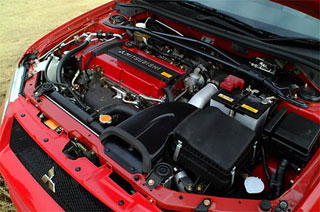 It should be noted that Lancer Evolution IV itself was amazing, who argues. Thus, we can observe a new technology that allows you to correct the driver’s flaws on the principle of rough patch, but by applying a thin seam.
It should be noted that Lancer Evolution IV itself was amazing, who argues. Thus, we can observe a new technology that allows you to correct the driver’s flaws on the principle of rough patch, but by applying a thin seam. Compared to the chassis in which the latest technical achievements are used, the changes made to the engine design are not so significant. Their list is this: a new intake and release system, thin adjustment of the turbine, improvement of the cooling system. As a result, the engine power (280 hp at 6500 rpm) remained the same (see the data of the Lancer Evolution VI), but the torque became more by 1 kg and reached the indicator 39.0 kg/m at 3,500 rpm.
I tested two cars equipped with AYC and ACD systems. If you take the last option as a sample, then the ACD system can be compared with the Gravel mode (graveling). On the last model, the turn is made smoothly, without unnecessary nerves.
In the photo there is an Assembly RS, which acts as a basic for racing modifications of the car. It provides for it to install the roof of the body and cover
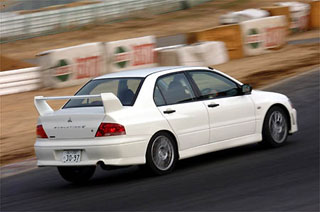 trunk from a sheet of small thickness. There are two types of transmission for this machine: with a high and low transmitting coefficient (the last type of box has an extended gearbox range). The seats have a regular design in this machine, there is neither air conditioner nor musical components in the cabin. The basic price of the car is 2.518,000 yen (about $ 24,000). The photo depicts a car that I performed a test trip. It just stands on the thin roof and trunk lid. The wheels of the wheels are 17-inch, the transmission is supplemented by AYC, ACD and ABS systems, the front wheels operate through the differential of high friction.
trunk from a sheet of small thickness. There are two types of transmission for this machine: with a high and low transmitting coefficient (the last type of box has an extended gearbox range). The seats have a regular design in this machine, there is neither air conditioner nor musical components in the cabin. The basic price of the car is 2.518,000 yen (about $ 24,000). The photo depicts a car that I performed a test trip. It just stands on the thin roof and trunk lid. The wheels of the wheels are 17-inch, the transmission is supplemented by AYC, ACD and ABS systems, the front wheels operate through the differential of high friction. Necessary notes
The VSC system (Vehicle Stability Control) monitors the stability of the machine using the elements of the clutch control system with expensive (ABS anti -lock system). If necessary, the system can drop the engine speed. In addition, when skidding or before the car enters, it individually transfers the desired brake force to each wheel to quickly correct the position of the car.
The AYC system (Active Yaw Control) distributes the torque between the rear wheels and serves to increase the maneuverability of the machine.
The ACD system (Active Center Differential) monitors the difference in the speed of rotation of the rear and front wheels using a multi -disc coupting with electronic control. The system supports the normal clutch of the drive wheels with the road when driving in 4WD mode, so that the controllability of the machine does not suffer. It works in three modes: Tarmac (driving around the ground), Gravel (riding gravel) and Snow (driving in the snow).
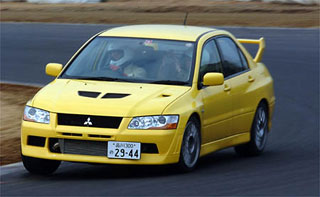 Modification Lancer Evolution VII called GSR. Its technical characteristics are given in the table below.
Modification Lancer Evolution VII called GSR. Its technical characteristics are given in the table below. Technical characteristics Mitsubishi Lancer Evolution VII GSR
Length / width / body height 4455 mm / 1770 mm / 1450 mm
Wheel base 2625 mm
4WD drive (full)
The engine is 2 liters, a 4 -cylinder line, turbo, with the intercooler, the gas distribution mechanism is two upper shafts with 16 valves, the developed power is 280 hp. at 6500 rpm, maximum torque 39.0 kg/m at 3500 rpm.
Transmission 5-speed manual transmission
Basic price 2 .998,000 yen (about $ 28.600)
Author: Mori Keita (Mori Keita)
Photo: Gundai Niro (Gundai Niro)
2001
Source: webcg







